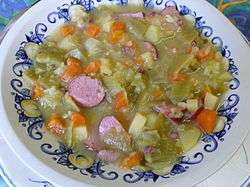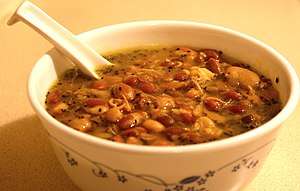List of bean soups
This is a list of notable bean soups, characterized by soups that use beans as a primary ingredient.
Bean soups
- 15 bean soup – a packaged dry bean soup mix produced by the N.K. Hurst Co. in the United States[1]
- Amish preaching soup – in American cuisine, it was typically served preceding or following Amish church services.[2][3] Some versions are prepared with beans and ham hocks.[4]
- Bissara – a soup and a bean dip in African cuisine, prepared with dried, puréed broad beans as a primary ingredient.[5][6][7][8]
- Black bean soup
- Bob chorba – a national Bulgarian dish, the name translates to "bean soup".[9] It is prepared using dried beans, onions, tomatoes, chubritza or dzhodzhen (spearmint) and carrots.[9][10]
- Bouneschlupp – a traditional Luxemburgish green bean soup with potatoes, bacon, and onions[11][12]
- Fasolada – a Greek, Levantine, and Cypriot soup of dry white beans, olive oil, and vegetables, sometimes called the "national food of the Greeks".[13]
- Frejon – a bean and coconut milk soup, it is consumed by some Christians on Good Friday in various areas of the world[14]
- Hong dou tang – or red bean soup is a popular Chinese dish[15] served in Mainland China, Hong Kong, and Taiwan. It is categorized as a tang shui (literally translated as sugar water), or sweet soup.
- Jókai bean soup – a Hungarian soup prepared using pinto beans
- Kwati – a mixed soup prepared using nine types of sprouted beans,[lower-alpha 1] it is a traditional Nepalese dish consumed on the festival of Gun Punhi, the full moon day of Gunlā which is the tenth month in the Nepal Era lunar calendar.
- Pasulj – a bean soup made of usually white beans, cranberry beans or pinto beans, and more rarely kidney beans, that is common in Serbian, Montenegrin, Bosnian, Croatian and Slovenian cuisines. It is a common winter dish, and is typically prepared with meat, particularly smoked meat such as smoked bacon, sausage, and ham hock.[17]
- Senate bean soup – served in the dining room of the United States Senate every day,[18] in a tradition that dates back to the early 20th century, it is prepared using navy beans, ham hocks, and onion.
- Stew peas – a Jamaican stew prepared using coconut milk, beans and salted meat,[19] it is a common in Jamaica and elsewhere in the Caribbean.
gollark: <@184468521042968577> Actually, I had a cooler idea - inter-server connectivity.
gollark: Which I think is only a few hundred meters off, so they probably could run fibre to everyone's house from it, but nooo...
gollark: The right end would be at that fibre box.
gollark: Well, that's probably because my server is on the wrong end of a VDSL line.
gollark: Or an equivalent desktop for maybe a third.
See also
- List of legume dishes
- List of soups
- Soup beans – a bean dish
Notes
- "Kwati is prepared by making beans sprout. Generally, it is said that there should be nine types of beans in the kwati. However, I found that the villagers in Sunakothi would only put four or five varieties in ..."[16]
References
- Erdody, Lindsey (March 2, 2016). "N.K. Hurst considers expanding operations into Zionsville". IBJ.com. Retrieved December 8, 2018.
- Mariani, John F. (1999). Encyclopedia of American Food and Drink. Lebhar-Friedman Books. p. 5. ISBN 0-86730-784-6.
- Mariani, J.F. (2014). Encyclopedia of American Food and Drink. Bloomsbury Publishing. ISBN 978-1-62040-161-3. Retrieved January 24, 2015.CS1 maint: ref=harv (link)
- Cronley, C. (2001). Sometimes a Wheel Falls Off: Essays from Public Radio. Hawk Publishing Group. p. 113. ISBN 978-1-930709-38-6. Retrieved January 24, 2015.CS1 maint: ref=harv (link)
- Weiss, J.; Chirichigno, P. (2007). Egyptian Cooking English Edition. Bonechi. p. 30. ISBN 978-88-476-0706-4.
- Valenta, Kyle (June 23, 2016). "How to eat breakfast like a local around the world - Provided By Advertising Publications". The Seattle Times. Retrieved September 6, 2016.
- Morse, K. (1998). Cooking at the Kasbah: Recipes from My Morroccan Kitchen. Chronicle Books. p. 63. ISBN 978-0-8118-1503-1.
- Good Eating's Global Dining in Chicago: Where to Find the City's Best International, Ethnic, and Exotic Restaurants. Agate Publishing, Incorporated. 2013. p. 71. ISBN 978-1-57284-443-8. Retrieved September 6, 2016.
- Kinser, K. (2014). Vegan Beans from Around the World: 100 Adventurous Recipes for the Most Delicious, Nutritious, and Flavorful Bean Dishes Ever. Ulysses Press. p. 29. ISBN 978-1-61243-285-4. Retrieved November 6, 2018.
- Albala, K. (2011). Food Cultures of the World Encyclopedia. Food Cultures of the World Encyclopedia. Greenwood. p. 67. ISBN 978-0-313-37626-9. Retrieved November 6, 2018.
- Goldstein, D.; Merkle, K.; Parasecoli, F.; Mennell, S. (2005). Culinary Cultures of Europe: Identity, Diversity and Dialogue. Council of Europe Pub. p. 282. ISBN 978-92-871-5744-7. Retrieved November 26, 2018.
- Sheehan, P. (2017). Luxembourg. Cultures of the World (Third Edition). Cavendish Square Publishing. p. 130. ISBN 978-1-5026-2738-4. Retrieved November 26, 2018.
- Λεξικό της κοινής Νεοελληνικής, 1998
- Omotosho, Kehinde (April 13, 2017). "Frejon: This is the traditional Easter meal of Lagosians". Pulse.ng. Retrieved December 8, 2018.
- Law, K.; Meng, L.C.; Tettoni, L.I. (2012). Authentic Recipes from China. Authentic Recipes Series. Tuttle Publishing. p. pt188. ISBN 978-1-4629-0534-8. Retrieved December 8, 2018.
- Löwdin, Per (1998). Food, Ritual, and Society: A Study of Social Structure and Food Symbolism Among the Newars. Mandala Book Point. p. 196. Retrieved December 8, 2018.
- "Serbian soldierly beans". The Serbian Cookbook. Retrieved 17 December 2015.
- Kessler, R. (1998). Inside Congress: The Shocking Scandals, Corruption, and Abuse of Power Behind the Scenes on Capitol Hill. Pocket Books. p. 74. ISBN 978-0-671-00386-9. Retrieved December 8, 2018.
- Higman, B.W. (2008). Jamaican Food: History, Biology, Culture. University of the West Indies Press. p. 269. ISBN 978-976-640-205-1. Retrieved December 8, 2018.
This article is issued from Wikipedia. The text is licensed under Creative Commons - Attribution - Sharealike. Additional terms may apply for the media files.

